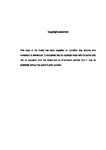Epidemiology and public health significance of bovine tuberculosis in cattle in the highlands of Cameroon
| dc.contributor.supervisor | Bradley, Graham | |
| dc.contributor.author | AWAH NDUKUM, Julius | |
| dc.contributor.other | Faculty of Science and Engineering | en_US |
| dc.date.accessioned | 2012-02-15T11:39:57Z | |
| dc.date.available | 2012-02-15T11:39:57Z | |
| dc.date.issued | 2012 | |
| dc.date.issued | 2012 | |
| dc.identifier | 10118240 | en_US |
| dc.identifier.uri | http://hdl.handle.net/10026.1/913 | |
| dc.description.abstract |
Bovine tuberculosis (TB) is a contagious neglected zoonosis of cattle that is prevalent but under-investigated in Cameroon, hence this study was designed to assess the epidemiology of bovine TB in cattle, risks for M. bovis infection in cattle and humans; and public health implications of zoonotic bovine TB in the highlands of Cameroon. A retrospective study of meat inspection records (1994 – 2010) was done to estimate the prevalence of TB lesions in slaughtered cattle in the North West region. The prevalence of bovine TB and anti-bovine TB antibodies in live cattle based on tuberculin skin tests (2 surveys) and immune-chromatographic assays respectively were carried out in the Western and Adamawa highlands of Cameroon. The performance of the tuberculin tests for bovine TB diagnosis in cattle using various tuberculin skin test cut-off points against the detection of anti-bovine TB antibodies (hypothesised risks of exposure) was compared. Suspected TB lesions from slaughtered cattle and infected human sputa were cultured on Lowentein – Jesen and Middlebrook 7H9 media to isolate mycobacteria agents for molecular genotyping using genomic deletion analysis and spoligotyping. Risk factors for exposure and transmission of zoonotic bovine TB infection of cattle and cattle professionals, and its public health significance were determined using structured questionnaires. Seventeen years of meat inspection record revealed that suspect TB lesions were identified in 599 of 129,165 slaughtered cattle at the Bamenda abattoir. The lungs and associated lymph nodes (over 60%) were the most affected tissues. Other results showed that the prevalence of anti-bovine TB antibodies in cattle in the study regions was 37.17%. Chi square statistics revealed that irrespective of the tuberculin test cut-off value (P<0.05; χ2>48), strong associations existed between the detection of anti-bovine TB antibodies and disease status. A 95% confidence interval analysis of the comparative cervical tuberculin tests revealed that the prevalence rates were 4.67% – 7.15%, 12.02% – 15.67% and 20.56% – 24.98% at the ≥ 4mm, ≥ 3mm and ≥ 2mm cut-off points, respectively. Overall, the best test performance was realised at ≥ 3-mm, though the ≥ 2-mm cut-off point predicted more positive reactors. Age, sex, breed and husbandry practices served as significant (P<0.05) risks to the prevalence and exposure of bovine TB in cattle. The feedbacks from cattle professionals suggested that there was high possibility of cattle to cattle and cattle to human transmission of bovine TB such as intimate and repeated animal / animal and animal / human interactions, consuming unpasteurised milk and eating raw meat. Genomic deletion analysis of cultured isolates showed evidence of M. tuberculosis from cattle and M. bovis from human while spoligotyping identified five cattle M. bovis strains; and four spoligotype patterns that had not been previously described anywhere. The study has important epidemiological and public health implications requiring prompt and decisive actions from the Cameroonian authority towards controlling zoonotic bovine TB in both humans and animals. A multidisciplinary approach is needed for further collaborative research and effective control strategies such as enhancing the awareness of people to this deadly disease through continuous education, proper food handling and personal hygiene, healthy husbandry practices and maintenance of the environment. | en_US |
| dc.description.sponsorship | Commonwealth Scholarship Commission in the UK | en_US |
| dc.language.iso | en | en_US |
| dc.publisher | University of Plymouth | en_US |
| dc.subject | Prevalence | |
| dc.subject | Bovine Tuberculosis | |
| dc.subject | Human Tuberculosis | |
| dc.subject | Anti-Bovine Tuberculosis Antibodies | |
| dc.subject | Tuberculin Skin Test | |
| dc.subject | Tuberculin Skin Test | |
| dc.subject | Tuberculous Lesions | |
| dc.subject | Mycobacterium Culture | |
| dc.subject | Acid-Fast Staining And Microscopy | |
| dc.subject | Molecular Genotyping | |
| dc.subject | Genomic Deletion Typing | |
| dc.subject | Spoligotyping | |
| dc.subject | Zoonosis | |
| dc.subject | Risk Factors Analysis | |
| dc.subject | Control | |
| dc.subject | Highlands of Cameroon | |
| dc.subject | Epidemiology | en_US |
| dc.title | Epidemiology and public health significance of bovine tuberculosis in cattle in the highlands of Cameroon | en_US |
| dc.type | Thesis | |
| dc.identifier.doi | http://dx.doi.org/10.24382/3431 |
Files in this item
This item appears in the following Collection(s)
-
01 Research Theses Main Collection
Research Theses Main


